Home » Fossils » Green River Formation Fossils
Green River Formation Fossils
Spectacular fish, plant, insect, bat, bird, turtle, horse and other fossils have been found
Article by: Hobart M. King, PhD, RPG
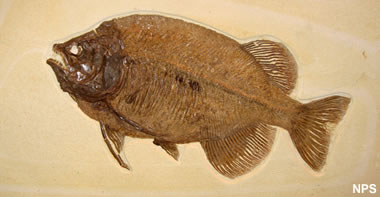
Green River Fossil Fish: Large teeth and rear-placed fins make Phareodus encaustus well suited for catching and eating other fish. View more Green River fish fossils. National Park Service - Fossil Butte National Monument photograph.
Story of the Green River Formation
Rocks of the Green River Formation contain a story of what the environment was like about 50 million years ago in what is now parts of Colorado, Utah, and Wyoming (see map below). At that time, forces within the Earth were almost finished with the job of uplifting the Rocky Mountains, and the landscape consisted of rugged mountains separated by broad intermountain basins.
Streams draining the steep mountains carried large amounts of sand, silt, mud and dissolved minerals into lakes that occupied the intermountain basis. Over time the sand, silt and mud began infilling the lakes. The dissolved minerals altered the chemistry of the lake waters. Abundant plants grew on broad swampy areas that developed around the margins of the lakes.
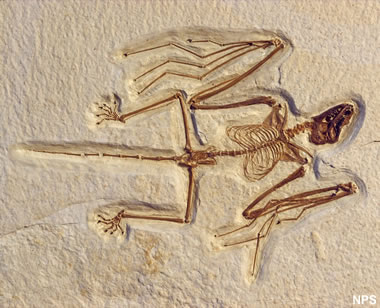
Green River Fossil Bat: This 5.5 inch long bat is the most primitive bat known. Claws on each finger of its wings indicate it was probably an agile climber and crawled along and under tree branches searching for insects. View more Green River animal fossils. National Park Service - Fossil Butte National Monument photograph.
Oil Shales and Coals
The Green River climate was moist and warm - perfect for rapid plant growth. This allowed a dense community of plants to spread across the swampy areas along the lake margins. These plants dropped a steady supply of leaves, branches, seeds and woody materials into the swamp waters. The water cover of the swamp protected the plant debris from decay and it accumulated rapidly. The plant debris layers grew thicker and more extensive over time. Eventually the layers of plant debris were buried and transformed into coal seams.
Conditions in the lakes were also ideal for thriving blooms of blue-green algae. They spread over many parts of the lakes as a thick scum of green filaments and strands. For several million years enormous amounts of algal debris sank to the bottom and were incorporated into the lake sediments. Through time the algae-rich sediments were transformed into the largest oil shale resource on Earth.

Green River Formation Map: Map showing the geographic extent of the Green River Formation of Colorado, Utah, and Wyoming. Map by Geology.com.
The Green River Lagerstätte
A lagerstätte is a sedimentary rock unit with an extraordinary fossil content. The Green River swamps and lakes provided an exceptional environment for fossil formation. The lakes and swamps were calm environments where remains were quickly buried by sediment. This resulted in one of Earth's most spectacular deposits of exceptionally preserved plants, animals, insects and fish.
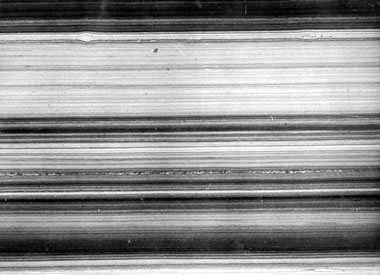
Green River Formation Varves: Varves in organic marlstone from a bed about 1800 feet above the base of the Green River Formation. The darker bands of rock contain the most organic matter. Garfield County, Colorado. 1927. Image by USGS.
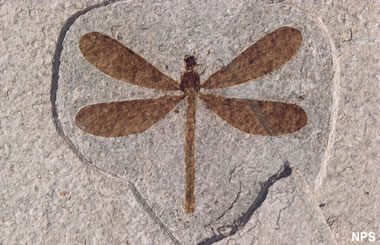
Green River Fossil Insect: Many species of insects are found in the Green River Formation, including dragonflies. The wetland margins of Fossil Lake provided ideal breeding and foraging opportunities. View more Green River insect fossils. National Park Service - Fossil Butte National Monument photograph.
Varved Sediments
In some parts of the lakes, sediments were deposited in very thin layers known as varves (see photo). A thin layer of dark-colored sediment was deposited during the growing season, and a thin layer of light-colored sediment was deposited in winter. The varves ranged in thickness from a fraction of a millimeter to a few millimeters each. Some of the most detailed and highly preserved fossils are contained in varved sediments composed of very fine-grained lime mud. When these thinly layered rocks are split, the smooth bedding surfaces often reveal a delicately preserved fossil.
Millions of Green River fossils have been collected by amateur and professional collectors. They are now in collections, exhibits and museums around the world. Photographs of a number of specimens are presented on this page. These photographs are from the archive of the National Park Service.

Green River Fossil Leaf: Two hundred and seventy-six leaves, seeds, and flowers are known from the Fossil Lake deposits. Fossil plants are key in determining the climate of past environments. View more Green River plant fossils. National Park Service - Fossil Butte National Monument photograph.
The Green River Formation is best known among paleontologists for its superbly preserved fossil fish. Some slabs of the Green River Formation contain hundreds of individual fish and likely represent an instantaneous die-off. Dozens of fish species have been identified. One species, Knightia, a small fish usually less than six inches in length, is especially common. Specimens of Knightia have made their way into thousands of fossil collections around the world.
An abundance of fossil plants have been found in sediments that accumulated along the edges of the lake. Palm leaves, ferns, and sycamore leaves are very common fossils of these Green River swamp sediments. Fossil of turtles, bats, birds, mammals, snakes, and crocodiles have also been found in the Green River Formation.
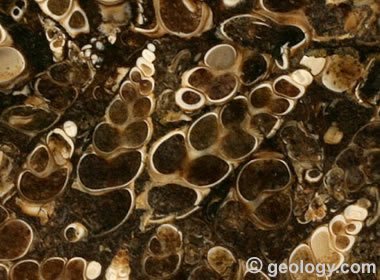
Turritella Agate: The Green River Formation is also the source of a fossil gem material known as Turritella Agate. It contains fossil gastropod shells.
Age of the Green River Fossils
Determining an accurate age for a rock unit can be very difficult. However, rocks of the Green River Formation have been dated to within a few million years through the analysis of volcanic mineral grains.
Volcanoes in what is now Yellowstone to the north and the San Juan volcanic field to the south produced occasional ash clouds that dropped thin layers of volcanic ash into the calm lake waters. These ash layers were preserved and contain tiny mineral grains that crystallized during the volcanic eruption. Researchers have collected samples of these ashfall layers and through analysis have determined the crystallization date of the tiny volcanic grains. They indicate that the lakes are about 50 million years old and span a time interval of several million years during the early to mid Eocene Epoch.
| More Fossils |
 |
Animal Fossils |
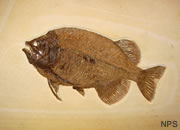 |
Fossil Fish |
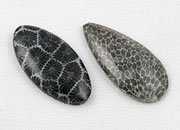 |
Fossil Gems |
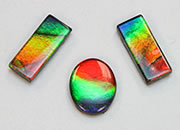 |
Ammolite |
 |
Gifts That Rock |
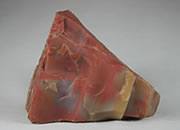 |
Petrified Wood |
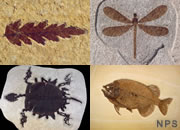 |
The Green River Formation |
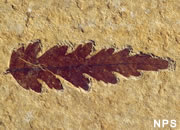 |
Plant Fossils |

Find Other Topics on Geology.com:

|

| ||

|

| ||

|

| ||

|

|
